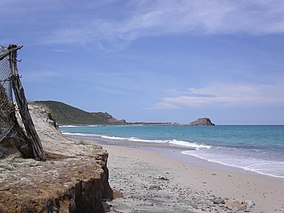Cabo Pulmo National Park
| Cabo Pulmo National Park | |
|---|---|
| Parque Nacional Cabo Pulmo | |
 Cabo Pulmo | |
| Location | Baja California Sur, Mexico |
| Area | 7,111 hectares (17,570 acres) |
| Established | 1995 |
| Governing body | Comisión Nacional de Áreas Naturales Protegidas |
| Designated | February 2, 2008[1] |
Cabo Pulmo is a national marine park on the east coast of Mexico's Baja Peninsula, Pulmo Point to Los Frailes Cape, approximately 60 miles (100 km) north of Cabo San Lucas. Bahía Pulmo is the location of the oldest of only three coral reefs on the west coast of North America. The reef, estimated to be 20,000 years old, is the northernmost coral reef in the eastern Pacific.[2][3] The reef has a number of fingers of hard coral atop rock outcroppings that run parallel to the coast [4] occurring in progressively deeper water offshore. On June 5, 1995, Mexican President Ernesto Zedillo declared the area surrounding Cabo Pulmo, a National Marine Park. Amigos para la Conservación de Cabo Pulmo, A.C. (Friends for the Conservation of Cabo Pulmo - ACCP) is a community organization founded in 2002 to promote conservation of the natural resources of the park.[5] In May 2 of 1997 Jose Luis Pepe Murrieta was the first volunteer Park Director appointed by the INE ( National Ecological Institute) while the federal government got enough budget for the Park, and then Carlos Narro was appointed the first official Park Director by La Comisión Nacional de Áreas Naturales Protegidas or CONANP in 2004.[6]
In his book The Log from the Sea of Cortez, John Steinbeck described Cabo Pulmo Reef as follows:
- "The complexity of the life pattern on Pulmo Reef was even greater than at Cabo San Lucas. Clinging to the coral, growing on it, burrowing into it, was a teeming fauna. Every piece of the soft material broken off, skittered and pulsed with life, little crabs and worms and snails. One small piece of coral might conceal 30 or 40 species, and the colors on the reef were electric.”
Before establishment of the park the area was heavily over fished. Creating the national park and policing it has been beneficial to the marine ecosystem. During the first decade of the 21st century the area has seen over 400% increase in total biomass. The increase is attributed to the healthy condition of the reef itself.[7]
References
- ^ "Ramsar List". Ramsar.org. Retrieved 11 April 2013.
- ^ Cabo Pulmo Coral Reef in Danger | AIDA
- ^ "Community structure of fishes in Cabo Pulmo Reef" (PDF). Marine Ecology. Retrieved 2012-02-09.
- ^ "Volume 52, May 2015, Pages 353–361". Ecological Indicators. Retrieved 2015-04-26.
- ^ Welcome to Cabo Pulmo National Marine Park
- ^ Welcome to Cabo Pulmo National Marine Park
- ^ Ocean Bonanza at Cabo Pulmo

